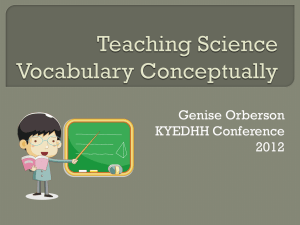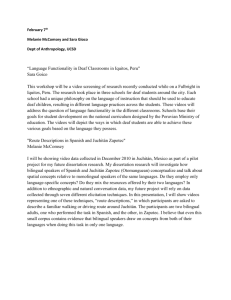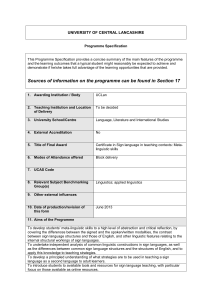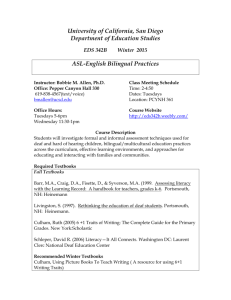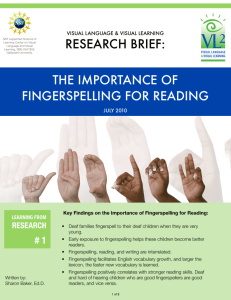The acquisition of English literacy skills by deaf adults in a bilingual
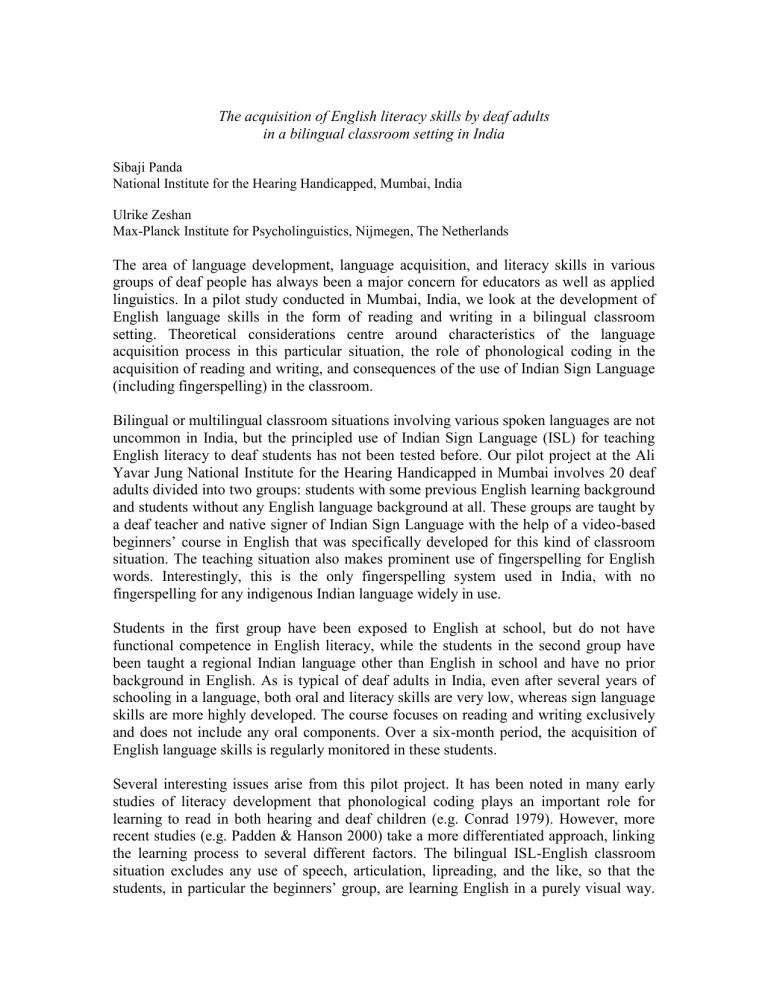
The acquisition of English literacy skills by deaf adults in a bilingual classroom setting in India
Sibaji Panda
National Institute for the Hearing Handicapped, Mumbai, India
Ulrike Zeshan
Max-Planck Institute for Psycholinguistics, Nijmegen, The Netherlands
The area of language development, language acquisition, and literacy skills in various groups of deaf people has always been a major concern for educators as well as applied linguistics. In a pilot study conducted in Mumbai, India, we look at the development of
English language skills in the form of reading and writing in a bilingual classroom setting. Theoretical considerations centre around characteristics of the language acquisition process in this particular situation, the role of phonological coding in the acquisition of reading and writing, and consequences of the use of Indian Sign Language
(including fingerspelling) in the classroom.
Bilingual or multilingual classroom situations involving various spoken languages are not uncommon in India, but the principled use of Indian Sign Language (ISL) for teaching
English literacy to deaf students has not been tested before. Our pilot project at the Ali
Yavar Jung National Institute for the Hearing Handicapped in Mumbai involves 20 deaf adults divided into two groups: students with some previous English learning background and students without any English language background at all. These groups are taught by a deaf teacher and native signer of Indian Sign Language with the help of a video-based beginners’ course in English that was specifically developed for this kind of classroom situation. The teaching situation also makes prominent use of fingerspelling for English words. Interestingly, this is the only fingerspelling system used in India, with no fingerspelling for any indigenous Indian language widely in use.
Students in the first group have been exposed to English at school, but do not have functional competence in English literacy, while the students in the second group have been taught a regional Indian language other than English in school and have no prior background in English. As is typical of deaf adults in India, even after several years of schooling in a language, both oral and literacy skills are very low, whereas sign language skills are more highly developed. The course focuses on reading and writing exclusively and does not include any oral components. Over a six-month period, the acquisition of
English language skills is regularly monitored in these students.
Several interesting issues arise from this pilot project. It has been noted in many early studies of literacy development that phonological coding plays an important role for learning to read in both hearing and deaf children (e.g. Conrad 1979). However, more recent studies (e.g. Padden & Hanson 2000) take a more differentiated approach, linking the learning process to several different factors. The bilingual ISL-English classroom situation excludes any use of speech, articulation, lipreading, and the like, so that the students, in particular the beginners’ group, are learning English in a purely visual way.
However, the use of fingerspelling may represent a bridge between ISL and English literacy. How successful this learning strategy can be sheds light on the nature of the language acquisition process itself.
It should also be noted that almost all studies in this domain are based on populations in industrialized countries, with practically no comparable studies conducted in developing countries, where deaf populations have quite different characteristics. The pilot project thus adds important new data from a different angle and a different situation to the existing studies on the subject of literacy development in deaf adults.
References
Conrad, R. (1979): The deaf schoolchild. London: Harper & Row.
Padden, C. & Hanson, V. (2000): Search for the missing link: The development of skilled reading in deaf children. In: Emmorey, Karen & Harlan Lane (eds.): The Signs of
Language Revisited: An Anthology to Honor Ursula Bellugi and Edward Klima.
Mahwah, NJ: Lawrence Erlbaum.

